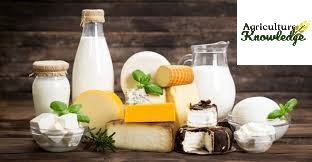Dairy Science- Milk, Dairy, Concept of Dairying, Dairy in India, Dairy Development in Different five years plans.
Milk
Milk is a liquid food and it is said to be nearly complete food, it secreated from mammary gland of female animals.
It is reach in vitamins, proteins, fat and specially in rich source of calcium, phosphorus and excellent source of vitamin A.
Milk is poor source of Iron And Vitamin C.
The colour of cow's milk is light yellow because of presence of Carotene.
The colour of buffalo milk is white because of Casein.
The boiling point of milk is 100.170C.
Dairy
It a place where milk and milk products like- cheese, butter, ghee, etc are stored.
Dairying
Dairying is the business for selling dairy products.
Concept of Dairying
- Dairying is the oldest form of economic supporter.
- In ancient era, goat, sheep, buffalo, cow, etc are the main sources of milk.
- Dairying concept starts from ancient time and continuing till now and in future also.
- Dairying is not very tough method so it is common and profitable.
Dairying in India-
- In India, mainly dairying is depend on buffalo, cow and goat.
- In India, buffalo is the first for dairying purpose.
- Cow is second and goat is on the third place for dairying in India.
- Day by day their is increase in demand of dairy product because of population growth.
- Dairying is very beneficial in terms of Indian economy.
- Dairy in India done by small scale to large industries.
- Largest dairy of Asia is Dudhsagar dairy with approx.1.41 million kg of milks each day.
Dairying Development in different five years plans
After Independence, for increasing the output and profit of milk products Indian government launched Five-years plan.
This plan is launched in stages of twelfth five year plan.
- First five year plan (1951-56)
- Second five year plan (1956-61)
- Third five year plan (1961-66)
- Annual Plan (1966-69) their are three annual plans-from (1966-67, 1967-68, 1968-69).
- Fourth five year plan (1964-74)
- Fifth five year plan (1974-78)
- Sixth five year plan (1980-85)
- Seventh Five year plan (1985-90)
- Eight five year plan (1992-97)
- Ninth five year plan (1997-02)
- Tenth five year plan (2002-07)
- Eleventh five year plan (2007-12)
- Twelfth five year plan (2012-17)
- This plan is for supplying good and hygiene milk to big cities.
- This plan is based on Harrod-Domar model.
- In Harrod-Domar model two things are higher saving and efficient investment.
- This plan is focused on development of agriculture and irrigation sectors.
- The plan target to increase 2% of GDP but it increases 3.6% that year.
- This plan is focused on development of public sector and rapid industrialization.
- This plan is also known as "Mahalanobis plan".
- This plan is focused on making economy independent and self-reliant.
- Plan disturbed because of war with Pakistan in 1965 and because of drought.
- This plan target was 5.6% but completed at 2.4%.
- This plan is also known as "Plan holiday".
- Plan holiday is launched because of Indo-Pakistan war & failure of third plan.
- Because of failure of third plan government launched this plan from (1966-67, 1967-68, and 1968-69).
- The slogan of this plan was "Garibi Hatao".
- The target of this plan is 5.7% but it achieved 3.3%.
- This plan is specially for agriculture and after that industry and mine.
- The target of this plan is 4.4% but it can achieved 4.8%.
- This plan focused on poverty eradication |(poverty free) and technological self reliance.
- The target of this plan was 5.2% but achieve 5.7%.
- The objective of this plan was for self sufficient economy and for productive employment.
- The target of this plan was 5.0% but achieved 6.0%.
- This plan is for development of human resources like- employment, education & public health.
- The plan was successful. The target of this plan was 5.6% but it achieved 6.8%.
- The target of this plan was 5.6% but it achieved 7%.
- This plan was launched in 50th year of Independence of India.
- This plan focused on growth with justice and equity.
- The main objective of this plan was reduce poverty rate by 5% by 2007.
- Provide employment and addition of labor force.
- The target of this plan was 8.1% growth but achieved only 7.7%.
- This plan was launched in presidency of Manmohan Singh.
- The aim of this plan was to increase enrolment in higher school of 18-23 years of age by 2011-12.
- The other aims of this plan was reduction in poverty, reduction in gender inequality, increase in agriculture growth to 4%.
- The target of this plan to achieved 8.2% but it achieved 8%.
- The aim is to provide electricity to all villages, enhance higher education, etc.
Dairy Production Statistics-
- In India, Uttar Pradesh is the largest of milk approx. 30.5 million metric tons.
- 187 million metric tons of milk is produced in India.
- India produced 20-22% of global milk.
- dairy production statistics depends on the total milk production of farmers.
- Approx. 91% of farm milk produces was delivered to dairy industries or on houses.
- Milk and dairy products plays a vital role in country economy.
- In India, U.P, Rajasthan, Gujarat, are major state of milk production.
- Rajasthan & Gujarat are the major milk producing state in India.
- Gujarat has number of cooperative dairy milk union, private dairy plants and primary milk cooperative societies.
- Indian dairy products demands are increased in foreign countries like- Bhutan, Afghanistan, Canada, U.A.E & Egypt.

Comments
It helps me alot.